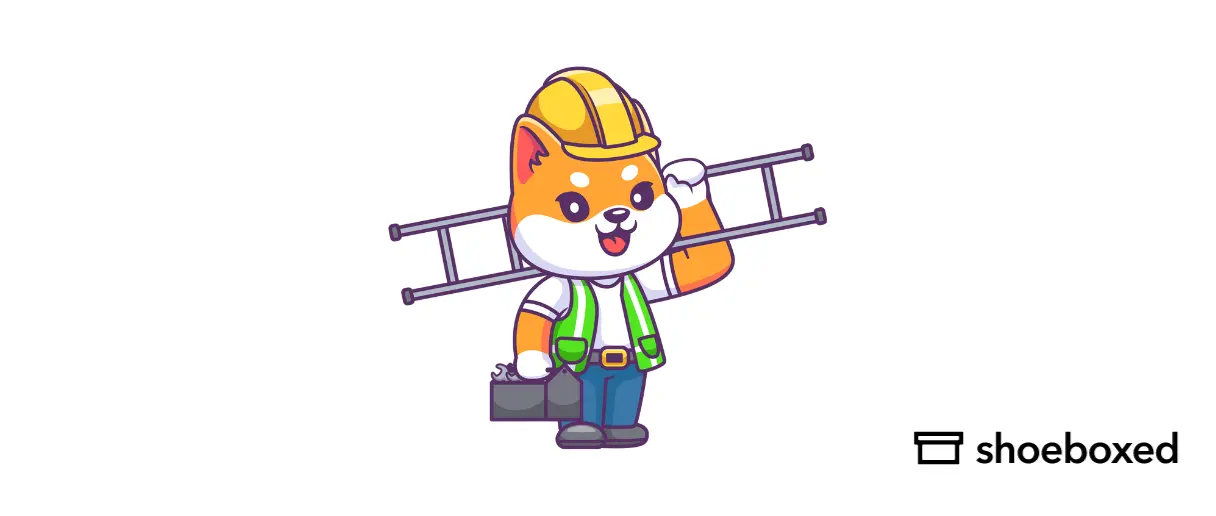There is no one-size-fits-all bookkeeping system. Every small business needs a system that considers its unique variables.
Construction companies are not exempt from this rule. Gaining a comprehensive understanding of the unique aspects of construction bookkeeping is not just beneficial, it's crucial to their success. The construction industry’s bookkeeping system must be tailored to its needs, considering all the variables that come into play with each job. By understanding these unique aspects, you equip yourself with the knowledge to navigate the financial landscape of your business effectively.
Implementing bookkeeping for your construction business may seem overwhelming, but it’s doable. We will not just provide you with theoretical knowledge, but walk you through the unique aspects of construction bookkeeping and give you practical tips that you can start using right away to make it easier.
How is construction bookkeeping different from bookkeeping in other industries?
Construction companies are project-based. The biggest issue here is no two projects are ever the same. Every project has its unique requirements and challenges.
1. Project-based vs. product or service-based
Most industries are product or service-based, but project-based industries are both. This includes sourcing materials, labor, consulting, engineering, and more. This means tracking business expenses in each category to clear a reasonable profit margin.
2. Length of contract
Project-based industries must also account for dry spells between projects or quick jobs in succession. Construction companies must factor this in when determining upfront payments or expenses. The length of construction projects makes the scheduling and collection of payments unique to the industry.
Not only that, but contracts vary in length from one job to another. That means money isn’t coming into the construction company every month. So, the bookkeeping system must be flexible yet organized enough to track cash flow when needed.
3. Always stay on top of overhead expenses
Since many construction companies charge per project, pricing can vary in the same categories from one project to another due to market fluctuations. Insurance premiums, material costs, subcontractor fees, equipment costs, and rentals can change at any time and affect the bottom line of each project.
So, when bidding on construction projects, each cost must be carefully examined by checking current market prices to win the bid. The construction industry is subject to economic, political, weather, and seasonal fluctuations.
Bookkeeping tips to account for the construction industry
Here are some practical tips for construction business owners on simplifying their accounting and financial management. These tips will help alleviate some of the headaches and save you time.
Tip #1: Keep separate journals for accounts payable, accounts receivables, and job costing
The key here is to keep all your business receipts. These receipts will show where your money is going and will be your lifeline if you are ever audited.
Here are the three journals and what they should include:
Accounts payable: company bills such as insurance, rent, utilities, and equipment.
Accounts receivable: client payments with date, amount, client’s name, and outstanding balance if applicable.
Job costing: material purchases, subcontractor payments, and payroll.
Make time to keep these journals current to track business expenses and receipts at any given time. These journals will be part of your bookkeeping records.
Tip #2: Use job costing to determine project costs
Job costing is a process that may seem complex at first, but it's a tool that can significantly enhance your financial management. By estimating job costs such as overhead, labor, and material costs, you can determine how much to charge for each project. This process, once understood and implemented, will give you a clear and confident understanding of your project costs, empowering you to make informed financial decisions.
Construction work would fall into the following three expense categories:
Labor is calculated by multiplying your workers' daily rate by the project completion days.
Materials are calculated by adding company costs and direct and indirect costs of the project together.
Overhead costs are calculated by adding rent, utilities, in-office salaries, professional fees, travel costs, advertising, and marketing expenses.
Add your income and expenses for each project to your general ledger. This will give you a snapshot of your net and gross income.
Tip #3: Have different business bank accounts for different purposes
First and foremost, whether you’re talking about construction accounting or any other business, separate your personal and business finances by opening a separate business bank account. This will make it much easier to account for your business expenses during tax time.
Having your construction company’s money in one account is frustrating and confusing. Having different accounts for payroll, taxes, client payments, and expenses will help you understand the company’s financial position.
This includes where the money is coming from and where it is going. This will give you a clearer picture of your company at the time.
Tip #4: Make sure your construction bookkeeping system accounts for contract retainage on your invoices
Contract retainage is a portion of the final payment held back until later to ensure the contractor has completed the project thoroughly and correctly. This is usually 5-10% of the contract price.
The best way to do this is to put this information on your invoices. To do this, put the milestone payment and amount on your invoice. Then, place a second set of numbers that reflect the retainage amount, which should be shown as a credit. This will give you the actual amount the client owes you. The final invoice will show the total retainage amount.
Tip #5: Use milestone payments to improve cash flow for construction businesses
Projects are broken down into stages or milestones. Payments are made after each milestone is reached. This is a much better payment schedule than getting paid in one lump sum at the end of the project. Having money coming in periodically throughout the project will improve your cash flow.
Tip #6: Base your revenue recognition on the length of the contract
Recording and determining when revenue is recognized is another essential part of the construction business accounting process. A construction company would use the following three methods for revenue recognition during its construction accounting process:
Most businesses use completed construction contracts for short-term contracts. Revenue is recognized after the project or contract is completed. By delaying revenue recognition, you also defer any related income tax recognition.
Many contractors use the installment method when clients pay over time. Revenue is recorded as soon as it is received from the client, and it is received in the construction accounting period.
The percentage of completed contracts is used for long-term projects in construction businesses. This method is an ongoing recognition of revenue resulting in a percentage of work completed in each accounting period. This way, you can track gains and losses from one accounting period to another.
Tip #7: Get a professional if you need bookkeeping for construction
With so many variables and every project being different, hiring a professional with industry experience for your bookkeeping and accounting services can significantly relieve many small business owners.
Having someone to meet your bookkeeping needs by providing basic bookkeeping services like monthly bookkeeping can free up a lot of time so you can focus on the important parts of your business, like sales and growth.
Tip #8: Automate your construction bookkeeping with accounting software
One of the best things you can do is automate your construction bookkeeping. This will save you time and frustration and eliminate human error. Construction companies are very specialized, and most accounting software provides essential bookkeeping services. QuickBooks Online is one example of accounting software that automates the bookkeeping process.
However, some bookkeeping software is more construction-specific than others. Even with general bookkeeping software, most will track expenses, manage payroll, generate financial reports like expense reports and balance sheets, categorize transactions, reconcile your bank account, and handle billing and invoicing.
You can even link your business bank account to the accounting software so it tracks your daily transactions and automatically records and updates them. That alone will save you a lot of time and money.
Another benefit of automating your construction accounting is paying quarterly taxes to minimize tax burden during tax time. The accounting software will also calculate your estimated payments.
How can you simplify and streamline construction bookkeeping?
Business owners can significantly simplify and streamline construction bookkeeping by automating receipt management, organizing expenses, and integrating with accounting software.
Shoeboxed - ideal for construction companies looking to simplify and streamline their bookkeeping
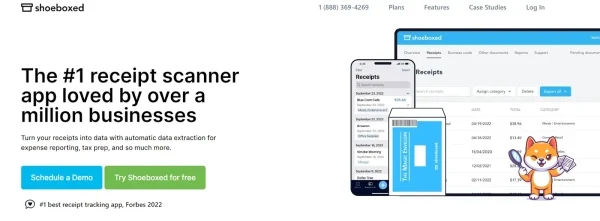
Shoeboxed is a receipt scanner that over a million businesses use to turn receipts into digital data with automatic data extraction for expense reporting, tax prep, and more.
Automated receipt management
Construction projects often generate large receipts for various expenses like materials, labor, and equipment.
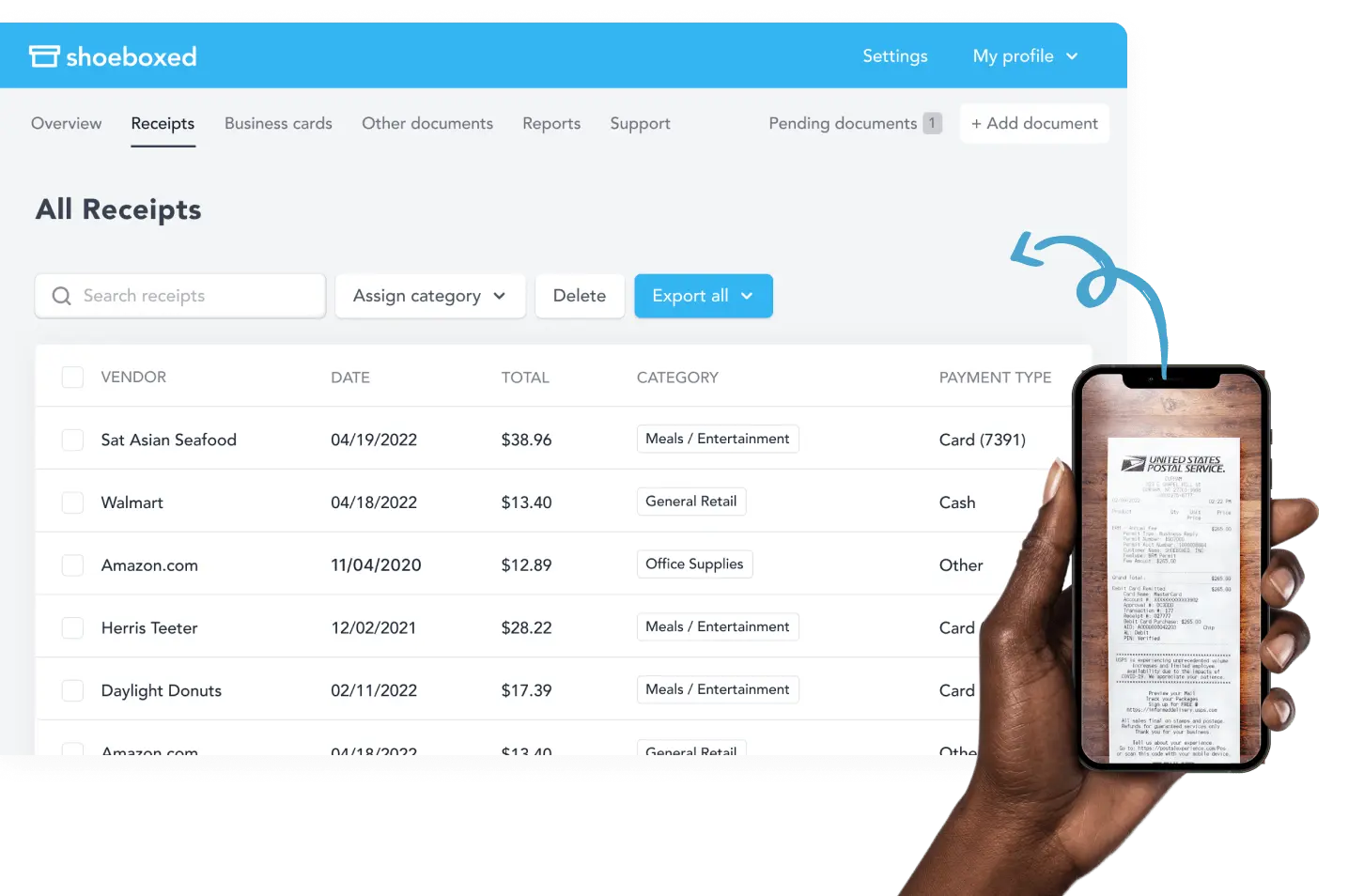
Shoeboxed allows users to digitize these receipts by taking photos with their mobile devices and using Shoeboxed's app to upload receipt data into a designated account.
Mobile access
The Shoeboxed mobile app lets construction workers capture receipts and track expenses directly from the job site. This ensures that all costs are recorded promptly, reducing the risk of lost receipts and unaccounted expenses.
Never lose a receipt again 📁
Join over 1 million businesses organizing & scanning receipts, creating expense reports, and reclaiming multiple hours every week—with Shoeboxed.✨
Get Started Today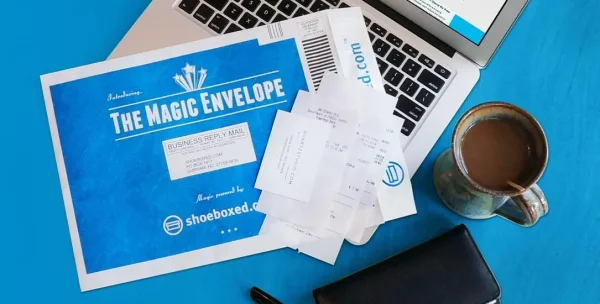
Shoeboxed provides a mail-in service for physical receipts if you want to outsource your scanning. Users can send their receipts in a prepaid envelope or Magic Envelope. Shoeboxed scans, digitizes, human-verifies, and uploads the receipts into your account, where they are stored securely in the cloud.
You can also email digital receipts from your inbox directly to your Shoeboxed account, use a custom Gmail plugin to auto-import digital receipts directly to your account or drag and drop receipts into the cloud using a laptop or desktop computer.
This significantly reduces the need for manual data entry.
Break free from manual data entry ✨
Use Shoeboxed’s Magic Envelope to ship off your receipts and get them back as scanned data in a private, secure cloud-based account. 📁 Try free for 30 days!
Get Started TodayExpense organization and categorization
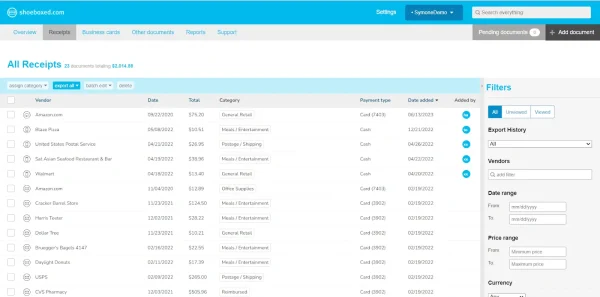
Once receipts are uploaded, Shoeboxed extracts critical information from receipts using OCR data extraction, such as vendor name, date, amount, and payment method, and categorizes these expenses automatically.
This helps maintain organized financial records, which is crucial for tracking project-specific expenses in the construction industry.
Users can also create custom tags to categorize expenses according to specific projects or clients, facilitating easier tracking and reporting of project costs.
Integration with accounting software
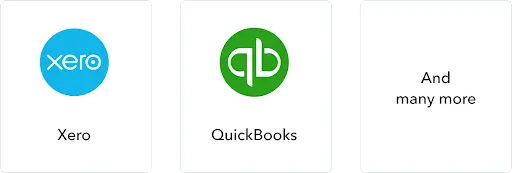
Shoeboxed integrates seamlessly with popular accounting software like QuickBooks, Xero, and Wave. This ensures that all digitized receipts and categorized expenses are automatically synchronized with the accounting software, reducing the potential for errors and ensuring that financial data is up-to-date.
Enhanced financial reporting
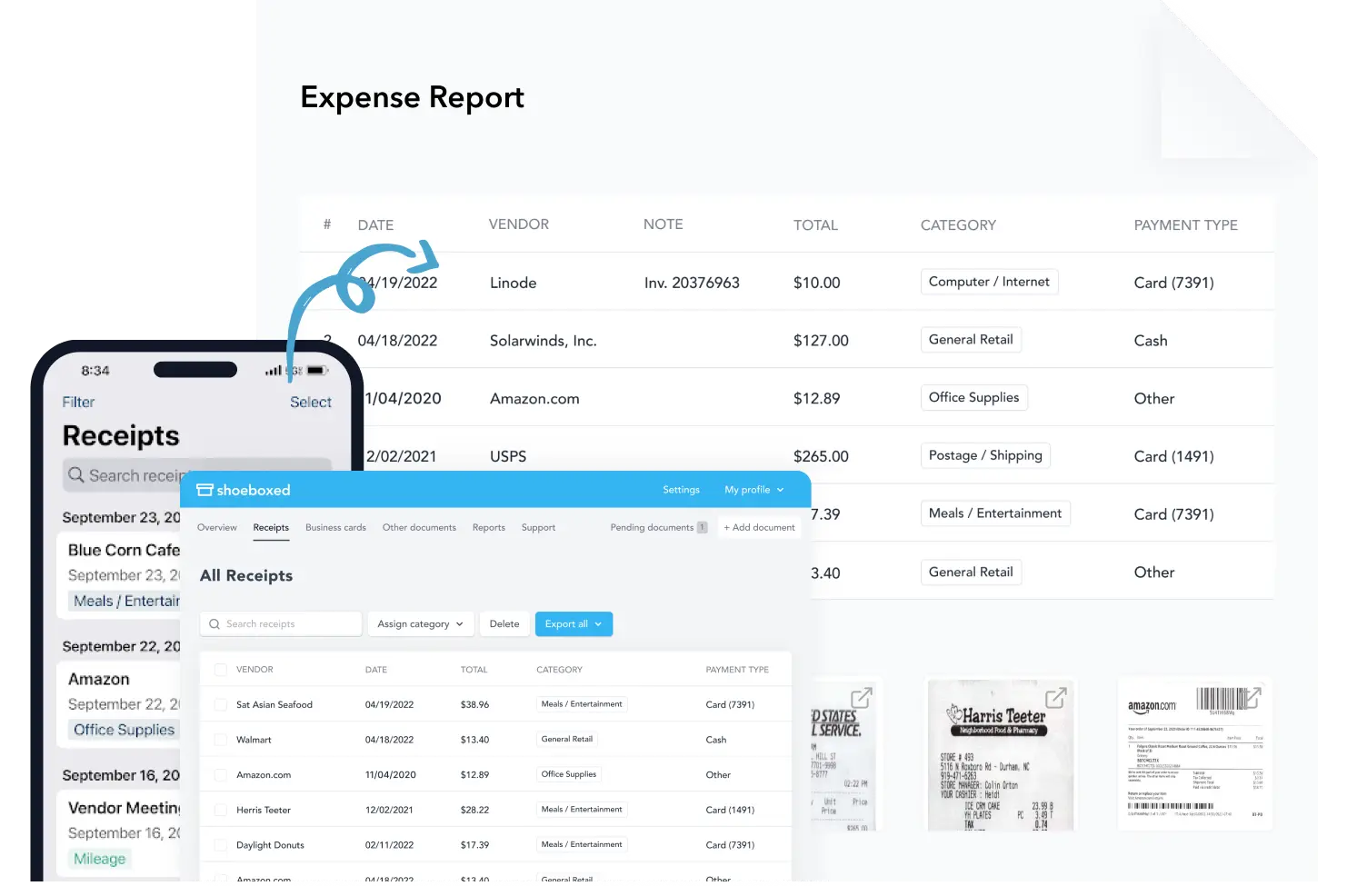
Shoeboxed generates detailed expense reports that can be customized to meet the specific needs of construction projects. These reports provide insights into spending patterns, aiding in budget management and financial planning.
Shoeboxed stores receipts in an IRS-accepted format, simplifying tax preparation and ensuring compliance. This is particularly important for construction companies, which must track deductible expenses accurately to minimize tax liabilities.
Turn receipts into data for tax time ✨
Try Shoeboxed’s systematic award-winning approach to receipt tracking for tax season. Try free for 30 days!
Get Started TodayTime and cost savings
By automating receipt management and expense tracking, Shoeboxed saves construction bookkeepers significant time. This allows them to focus on more strategic tasks such as financial analysis and planning.
Automation reduces the likelihood of errors in financial records, leading to more reliable financial reporting and better decision-making.
Shoeboxed enhances construction bookkeeping by automating and streamlining the receipt management process, organizing expenses, and integrating with accounting software. These features help construction companies maintain accurate financial records, ensure tax compliance, and save time and resources, making Shoeboxed a valuable tool for managing the economic aspects of construction projects.
Turn receipts into data with Shoeboxed ✨
Try a systematic approach to receipt categories for tax time. Try free for 30 days!
Get Started TodayWhy is construction bookkeeping essential?
The construction industry is complex, with many variables at play at every stage. There’s a lot to track, and multiple projects are happening at different locations. That’s a lot!
Bookkeeping keeps all this information organized and up to date. Construction bookkeeping considers all the variables specific to the construction industry, so bookkeeping and financials are accurate. Better bookkeeping equals a better construction company which means more money in your pocket.
Frequently asked questions
What financial records need to be kept in construction bookkeeping?
In construction bookkeeping, you must keep several financial records to track them accurately and comply with regulations.
These include:
Job costing reports Track costs associated with specific projects, including labor, materials, subcontractors, and overhead. These reports show each project’s profitability.
Invoices and receipts: Keep copies of all invoices and receipts for expenses sent to clients. This tracks income and expenses.
Payroll records: Document all employees' hours worked, wages paid, and taxes withheld. Payroll records are required for labor compliance and project labor cost management.
Bank statements and reconciliations: Reconcile bank statements with your accounting records to ensure all transactions are recorded correctly and to find discrepancies.
Accounts payable and receivable: Keep records of amounts owed to suppliers (accounts payable) and amounts due from clients (accounts receivable). This manages cash flow and ensures timely payments and collections.
How do construction companies implement job costing?
Job costing is critical for construction companies to be profitable and project successful.
Here are ways to job cost effectively:
Detailed estimates: Start with accurate and thorough project estimates that include all costs, such as labor, materials, equipment, and subcontractors. Use historical data and industry benchmarks to improve your estimates.
Regular tracking and updates: Track job costs throughout the project lifecycle. Update costs regularly to reflect actual expenses and compare them to estimates to find variances.
Technology: Use construction-specific accounting software with job costing features. These tools can automate data entry, generate real-time cost reports, and provide project performance insights.
Labor cost management: Track labor hours and costs by project. Use time tracking tools to record employee hours accurately and allocate labor costs to the right jobs.
Regular review and analysis: Review job cost reports with project managers and stakeholders periodically. Analyze the data to find trends, cost overruns, and areas for improvement. Use this information to make informed decisions and adjust project plans as needed.
In conclusion
Effective construction bookkeeping is crucial for the financial health and operational efficiency of construction companies. By maintaining accurate financial records, managing job costing diligently, and leveraging technology like Shoeboxed, construction firms can streamline their financial processes and ensure compliance with regulatory requirements.
Shoeboxed simplifies the receipt management and expense tracking processes, allowing bookkeepers to focus on higher-value tasks such as financial analysis and strategic planning. As the construction industry continues to evolve, adopting robust bookkeeping practices and integrating advanced tools will be essential for sustaining growth and profitability.
Caryl Ramsey has years of experience assisting in different aspects of bookkeeping, taxes, and customer service. She uses a variety of accounting software for setting up client information, reconciling accounts, coding expenses, running financial reports, and preparing tax returns. She is also experienced in setting up corporations with the State Corporation Commission and the IRS.
About Shoeboxed!
Shoeboxed is a receipt scanning service with receipt management software that supports multiple methods for receipt capture: send, scan, upload, forward, and more!
You can stuff your receipts into one of our Magic Envelopes (prepaid postage within the US). Use our receipt tracker + receipt scanner app (iPhone, iPad and Android) to snap a picture while on the go. Auto-import receipts from Gmail. Or forward a receipt to your designated Shoeboxed email address.
Turn your receipts into data and deductibles with our expense reports that include IRS-accepted receipt images.
Join over 1 million businesses scanning & organizing receipts, creating expense reports and more—with Shoeboxed.
Try Shoeboxed today!



